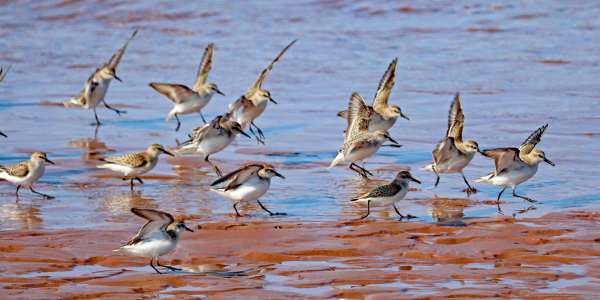The inner Bay of Fundy is a renowned fall migration stopover site for Semipalmated Sandpipers spanning the territory of the Mi’kmaq, Wolastoqiyik, and Peskotomuhkati Nations and provinces of Nova Scotia and New Brunswick. Its global conservation value is recognized through several designations, which include Important Bird Areas, Key Biodiversity Areas, UNESCO Fundy Biosphere Region, and Western Hemisphere Shorebird Reserve Network.
Semipalmated Sandpipers, or “Semis”, arrive in the Bay of Fundy from their Arctic nesting grounds in late summer. Over three weeks they feed on tiny invertebrates found on mudflats and double their weight to fuel an epic 3-day non-stop flight to South America. When their mudflat feeding habitat is submerged during high tide, large flocks gather at coastal beach roost sites to rest until feeding can begin again on the falling tide.

Semipalmated Sandpipers. Photo: D. Ross Fisher
Peak migration in August coincides with peak summer beach recreation for Maritimers and visitors, so shorebirds can have a difficult time finding quiet beaches free from disturbance. We needed a fun and accessible educational tool to help coastal visitors understand why shorebirds need rest time on beaches and how to help. So, Birds Canada collaborated with inner Bay of Fundy shorebird conservation partners to develop a short video. We’re thrilled to launch the video this summer – just in time for shorebird migration. Check it out and please share widely!
We are very grateful to Nature NB, St. John Naturalists’ Club and Nature Conservancy of Canada for collaborating on the video and to Rob Hansen and Veronica Sherwood for producing it.
This project was undertaken with support from the Department of Environment and Climate Change as well as the Nova Scotia Habitat Conservation Fund.

